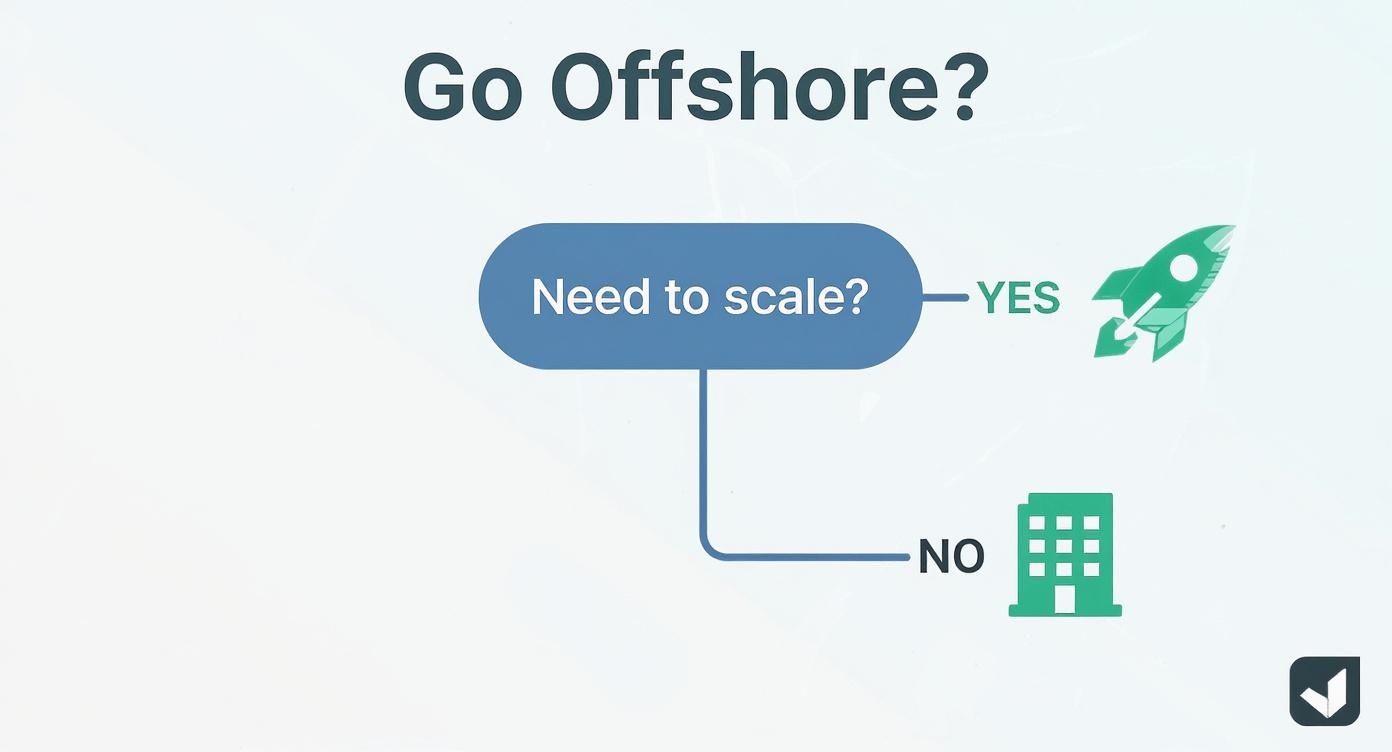
Let's be real. You're probably here because hiring a senior developer in San Francisco costs about the same as a small private island. The phrase offshore app development gets tossed around a lot—for some, it's a magic bullet; for others, a horror story whispered in hushed tones.
So what is it? It’s hiring developers in other countries to build your software. Done right, it's one of the most powerful levers you can pull to scale your tech team. Done wrong? Well, let’s just say it’s a fast track to burnout and a codebase that looks like spaghetti.
You’ve heard the advice, maybe from a VC who just cut your funding: “Go offshore.” The immediate thought is always about saving a buck. And while the cost savings are a massive plus, framing offshore development as just a budget play is like saying a Ferrari is just a way to get groceries. It completely misses the point.
Sure, the sticker shock of a Bay Area developer's salary is enough to make anyone look for alternatives. But the true strategic advantage isn't just about swapping a $200,000 salary for a $70,000 one. It’s about what that newfound capital efficiency actually unlocks.
Imagine this: the budget you had for two local senior developers now gets you a full team of six. That’s not just a line item reduction; it’s a dramatic acceleration of your entire product roadmap.
Suddenly, you're not forced to choose between building that game-changing new feature or finally tackling that nagging tech debt. You can do both. The opportunity cost of not building something is often far greater than the cost of development itself. Going offshore lets you say "yes" to innovation more often.
Here's a thought: the absolute best engineer for your niche React Native project probably doesn't live within a 20-mile radius of your office. Shocker, I know. Limiting your talent search to a single city is like fishing in a puddle when there's an entire ocean of talent out there.
Hiring globally gives you access to specialized skills that might be outrageously expensive or just plain unavailable in your local market.
The Ground Truth: You're not just hiring "cheaper" developers. You're hiring elite, globally-sourced talent at a sustainable price point. This shift in mindset is what separates a frustrating outsourcing experiment from a genuine competitive advantage.
The industry numbers tell the same story. The offshore development market is a behemoth, valued at around $365 billion, with a staggering 81% of public tech companies already using global teams.
And it’s only getting more efficient. When you factor in how AI tools can boost an offshore developer's productivity by 40%, a developer earning $66,000 can realistically deliver the output of a $200,000+ US-based engineer. You can learn more about how modern tools are reshaping the industry on Full Scale's blog. This isn’t some fringe tactic anymore; it’s how modern tech companies get built and win.
So, you've decided to stop paying Silicon Valley rents for your talent. Smart move. But before you start sending out offers across the globe, you need a game plan. Turns out there’s more than one way to hire an offshore app development team, and picking the wrong one is like showing up to a marathon in flip-flops. It's painful, and you won't get far.
Let’s get brutally honest about the three main paths you can take.
This is the "turnkey" promise. You hand over a check and a project brief, and an agency says they'll deliver a finished app, wrapped in a neat little bow. Sounds fantastic, especially if you're swamped and just need the thing done.
But here’s the rub: you trade control for convenience. You’re not just paying for developers; you're paying a premium for their project managers, account executives, and that swanky office with the kombucha on tap. Communication gets filtered, development turns into a black box, and you might find your "dedicated" team is actually juggling three other clients.
The agency model is like ordering a prix-fixe meal. It’s easy, but you don't get to talk to the chef, and you're paying for a lot more than just the ingredients.
This model can work for one-off projects with a crystal-clear, never-going-to-change scope. But for a real product that needs to evolve? You'll find yourself battling change orders and opaque hourly billing that mysteriously inflates your budget every month.
Next up, the Wild West of hiring: freelance platforms. The appeal is obvious—seemingly endless choice and the flexibility to hire someone for a week, a month, or just a few hours. On the surface, it feels like the ultimate agile solution.
The reality? Hope you enjoy spending your afternoons fact-checking resumes and running technical interviews—because that’s now your full-time job. You instantly become a project manager, talent sourcer, and international payroll expert all at once. Trying to herd a group of disconnected freelancers into building a cohesive, scalable product is a masterclass in frustration.
The biggest headaches with this approach include:
This visual helps clarify when the jump to an offshore model stops being a "nice-to-have" and becomes a strategic necessity for scaling your company.

The key takeaway is that when growth is the priority, expanding your talent search globally is no longer an option—it's the core strategy.
This is what I consider the holy grail. It’s the model that gives you the best of both worlds: the cost-effectiveness of global talent with the integration and control of an in-house team. Your offshore developers aren’t just temporary contractors; they're full-fledged members of your crew. They’re in your Slack channels, they attend your stand-ups, they contribute to your culture, and they are genuinely invested in your product's success.
The catch has always been the immense operational lift. How do you find these people? How do you properly vet them? And, the big one, how on earth do you handle international contracts, payroll, benefits, and compliance without hiring a team of lawyers? It’s a logistical nightmare waiting to happen.
This is exactly why platforms like LatHire exist. (Toot, toot!) We handle all the messy, complicated parts—the sourcing, the rigorous vetting, compliance, and payroll—so you can focus on what you do best: building your team and your product. You get the dedicated, loyal team member without the administrative brain damage. It’s the only model that truly scales with you.
While this guide focuses on offshore teams, you might also find value in our comparison of offshore vs. nearshore development models to further refine your strategy.
To make this crystal clear, I've broken down the real-world pros and cons of each model. This isn't marketing fluff; it's what you can actually expect when you're in the trenches.
| Model | Best For | Real Cost | Your Level of Control | Biggest Headache |
|---|---|---|---|---|
| Agency | One-off, fixed-scope projects where you just need it done. | High. You're paying for their overhead, PMs, and profit margin. | Low. It's a black box. You provide input, they deliver (eventually). | Scope creep and budget overruns from endless "change requests." |
| Freelancers | Short-term tasks, bug fixes, or finding a niche expert for a few weeks. | Variable. Seems cheap upfront, but hidden management time adds up fast. | High (in theory). You direct everything, but it's like herding cats. | Quality control and the risk of key people disappearing overnight. |
| Dedicated Team | Building a long-term, scalable product with a core, integrated team. | Medium. Higher than freelancers, but 40-60% less than an agency or local hires. | Total. They are your team, managed by you, working on your priorities. | The administrative burden of global hiring (unless you use a platform). |
Ultimately, the right model depends on your goals. If you're building a business, not just a one-time project, investing in a dedicated team is almost always the right call for long-term success and sanity.
Alright, you're ready to build your offshore team. The first—and most common—mistake is to open a spreadsheet, list countries, and sort by the lowest hourly rate.
Stop right there. If that's your game plan, you're not making a strategic business decision; you're just gambling.
Spoiler alert: this isn't about finding the cheapest keyboard warrior. The world is massive, but the talent pool that's actually right for your company is much smaller. Picking a region is a serious decision that has to balance cost, raw talent, cultural fit, and how much friction you're willing to put up with. Nail this, and you've got a huge competitive edge. Get it wrong, and you'll burn the next year fighting time zones and rewriting spaghetti code.
Let's just skip the generic "Top 5 Countries for Outsourcing" listicles you've already seen a dozen times. They're useless. Instead, let's talk about what really matters when you're trying to build a real product with a team you can count on.
This isn't just about picking a spot on the map. It's about finding a strategic extension of your company's DNA. You’re not just hiring another pair of hands; you’re growing your team.
So, where should you actually be looking? The honest answer is: it depends entirely on what you prioritize.
Latin America (Brazil, Colombia, Mexico)
Think of Latin America as the "timezone advantage" play. For any company in the US or Canada, the ability to work in almost perfect sync is a massive operational win. The talent pool is deep, especially in front-end frameworks and UI/UX, and the cultural alignment is often far closer than you'd find halfway around the globe. It’s the go-to choice for teams that need high-touch, daily collaboration. Our guide to the best countries for outsourcing breaks down the specific strengths of each major Latin American hub.
Eastern Europe (Poland, Romania, Ukraine)
This region is an absolute powerhouse of deep, hardcore technical talent. If you're building a complex back-end, wrestling with intricate algorithms, or need world-class engineers who live and breathe clean architecture, this is where you look. Developers here are known for being direct, pragmatic, and exceptional problem-solvers. The quality is consistently top-tier, but the rates reflect that—this is a "value" play, not a "cheap" one.
India
You simply can't talk about offshore development without mentioning India. The sheer scale of the talent pool is unmatched anywhere else on the planet. If your goal is to hire ten qualified mobile developers in a month, India is one of the few places you can realistically pull that off. The ecosystem is mature, the costs are highly competitive, and you can find niche expertise in virtually any tech stack imaginable.
My Take: There's no single "best" place. The smartest companies I've seen don't just pick one region; they build a global, hybrid strategy. Today's offshore development strategies often involve sophisticated hybrid models that combine different talent hubs for maximum efficiency. For example, many businesses build round-the-clock development cycles with teams in India handling work overnight while nearshore counterparts in Latin America cover overlapping US hours. To see how these trends are shaping modern tech teams, you can discover more insights about top offshore software development trends on Jellyfish Technologies' blog. The goal is to build a resilient, distributed team that leverages the unique strengths of each region.

So, you've posted a job and the résumés are flooding in. Congratulations. Now the real fun begins.
This isn't just about finding someone who can code. It's about finding someone who can think critically, communicate clearly, and collaborate effectively from another continent. Get this part wrong, and you'll be dealing with the fallout for months. Nail it, and you'll wonder why you ever bothered hiring locally.
First things first: a résumé is a marketing document, not a factual report. Relying on it to screen candidates for your offshore team is a rookie mistake. A slick PDF tells you nothing about a developer's real ability to ship clean, maintainable code.
So, where do you begin? You need a process that weeds out the talkers and elevates the doers before you ever waste a minute on a video call.
This is where a well-designed skills test becomes your best friend. A good test isn't some abstract brain teaser; it’s a small, real-world problem that mirrors the work they'll actually be doing. The goal is to see how they think, not just if they memorized an algorithm. At LatHire, our own vetting is obsessive because we’ve learned this lesson the hard way. Building a solid process for pre-employment skills testing is non-negotiable.
Once a candidate passes your skills test, it's time for the human element. The video interview isn't just a final technical screen; it's your only real chance to gauge the soft skills that make or break a remote hire.
Anyone can claim to be a "great communicator" on their LinkedIn profile. Your job is to poke holes in that claim.
Forget asking, "Are you a good communicator?" Instead, ask, "Tell me about a time you disagreed with a technical decision from your lead. What did you do?" Their answer reveals everything about their confidence, collaboration style, and ego.
Here are the questions that actually matter:
When you're ready to grow, these insights offer some great expert tips for hiring remote software developers that can sharpen your process even more.
I'm a huge believer in this final step. Before you sign any long-term contract, offer a one-week paid trial project. Give them a real, non-critical ticket from your backlog.
This isn’t about just seeing if they can complete it. It's about seeing how they do it.
A one-week trial gives you a more accurate signal on a candidate's skills and work ethic than ten hours of interviews ever could. It’s the best way to make a hire you won't regret in three months. Skip this step at your own peril.

Hiring a brilliant developer feels great, doesn't it? You found your rockstar. But that was the easy part. Now comes the challenge where most companies stumble: actually integrating them into your team and workflow.
Let's be blunt. You can't just add an offshore developer to a Slack channel and hope they absorb your company's DNA through osmosis. They aren't sitting next to your product manager, overhearing side conversations about new customer feedback or a last-minute change in priorities.
If you treat onboarding as just a checklist, you're setting yourself up for failure.
Your onboarding process needs to be ruthlessly clear. A new hire thousands of miles away doesn't have the luxury of tapping a coworker on the shoulder to ask a "stupid" question. This is where a documentation-first culture becomes your secret weapon.
If it isn't written down, it doesn't exist. Period. This means everything:
Think of your documentation as your remote office. It’s where culture is codified and knowledge is shared. A half-baked Confluence page just won’t cut it.
You can't manage a global team with email and good intentions. Your tool stack is the central nervous system of your remote operation. You don’t need a dozen subscriptions, but you absolutely need the right ones.
The goal here is to create "ambient awareness," where everyone has a clear view of what’s happening without needing constant meetings. Speaking of which…
The 3 AM Stand-up Call: Stop it. Just stop. Running meetings across wildly different time zones requires empathy. Record important all-hands meetings, rotate meeting times to share the inconvenience, and lean heavily on asynchronous updates. Nobody does their best work after being jolted awake by a calendar alert.
I’ve seen founders obsess over hours logged on a timesheet. It’s a fool’s errand. You're not paying for keystrokes; you're paying for progress. To effectively manage an offshore team and ensure productivity, using the right tools is key. While some prefer manual check-ins, many find that the best time tracking software helps maintain focus on output without micromanaging.
Your KPIs should reflect real business value, not just busyness. Focus on these three:
The scale of this industry backs this up. The offshore software development market is projected to hit $151.9 billion, with North American companies alone contributing $46.2 billion of that. This massive investment isn't just about finding cheaper labor; it's about building efficient, output-driven systems that allow companies to scale rapidly.
You’ve got the process down, the people are in place, and the tools are all set up. So, you're done, right? Not even close. Now comes the secret sauce—the stuff nobody ever puts in a project plan but makes all the difference between a team that just ships code and one that truly drives your business forward.
This is where we get into the hard-won lessons that transform a good offshore app development team into an indispensable extension of your own.
Let's start with the most important rule of all: stop treating your offshore team like a vending machine for code. You don't just put in a request and expect a perfect feature to pop out. These are your colleagues, your teammates. They just happen to be working from a different zip code.
The moment you shift your mindset from "outsourced vendor" to "distributed colleague," everything changes. You start including them in the why behind a project, not just the what. And in return? They start offering ideas you hadn't even considered because they feel a real sense of ownership.
This isn't just fluffy, feel-good advice. It’s a pragmatic business strategy. Teams with high psychological safety—where people feel comfortable enough to speak up, ask "dumb" questions, and challenge ideas—consistently outperform those that don't. It's really that simple.
In a remote setting, there is no such thing as over-communication. What feels like stating the obvious to you might be a critical piece of context for someone thousands of miles away.
I once sent a developer in Brazil a t-shirt from my favorite local coffee shop. The whole thing, shipping included, cost me maybe $40. He later told me it meant more to him than his end-of-year bonus because it made him feel seen and part of the team, not just a contractor on a spreadsheet.
This isn’t about buying extravagant gifts. It's about thoughtful, human gestures. A small, personalized item, a handwritten thank-you note, or even a surprise day off after a tough launch—these are the small hinges that swing big doors. They build loyalty and trust in a way that no contract or project bonus ever could.
Alright, you've made it this far, but I bet a few nagging questions are still rattling around in your head. Let’s tackle them head-on. No fluff.
You've got a few choices here, ranging from “total overkill” to “just right.”
Some companies consider setting up a foreign entity, but that's a complex route and rarely necessary for hiring a few developers. The most common path is using contractor agreements specific to the developer’s country, which is better but still leaves you navigating foreign labor laws.
A much smarter move? Using an Employer of Record (EOR) service. Platforms like ours handle all the local compliance, payroll, and taxes for a simple fee. It completely removes the legal and administrative burden from your plate. Just promise me you won't start wiring money without a rock-solid contract that clearly covers IP ownership.
This varies wildly depending on the region and experience level, but it's crucial to get the idea of 'cheap' out of your head and start thinking about 'value'.
In talent-rich regions like Latin America or Eastern Europe, you should expect to pay anywhere from $4,000 to $8,000 USD per month for a skilled senior developer. That’s a fraction of what you’d pay in the US for the same caliber of talent.
If you see rates under $25/hour, run. The goal isn’t to find a $20k-level developer for $20k; it’s to hire a $150k-level developer for $70k. There’s a world of difference.
This is the big one, and it's something you absolutely cannot afford to get wrong.
Your first line of defense is an ironclad contract. Make sure your agreement includes strong IP assignment clauses that explicitly state all work product—every line of code, every design, every document—is owned by your company, period. No ambiguity.
Second, control your technical environment. Use secure cloud infrastructure like AWS or Google Cloud and limit access to sensitive code repositories on a strict need-to-know basis.
Finally, work with reputable partners. A fly-by-night freelancer found on a generic marketplace has very little to lose if things go south. A dedicated platform has its entire reputation on the line, which means our interests in protecting your IP are perfectly aligned with yours.